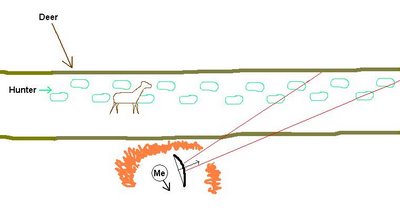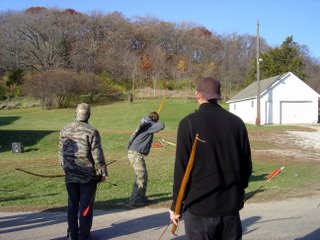I drove to this spot and parked. Signs said hunting was allowed to the left side of the main road. The right side is where the lake was. There was almost no one around which was a good sign. I found a trail and entered the forest. I was able to find a deer track on the trail. I thought deer probably bed up the hill during the day and come down to the lake at night.
I was having trouble finding a good spot to set up along the trail so at some point I decided to use inner vision. Since I couldn't figure it out based on my little knowledge and experience, I put it to my spirit to get me through. I was led along the trail up hill. As I got near the top I came upon a pretty wide trail. At the top of the hill was a large cylindrical tank so I thought the trail could possibly be a service road. The trail would have barely fit a car down it though so I wasn't sure. I followed this trail along the ridge. I was directed to a spot on the uphill side of the trail.
The spot seemed perfect. There were small beach saplings on the edge of the trail to use as cover. Beach trees are a type of tree that tend to keep their leaves during fall. While most of the trees around were bare my spot had leaf cover. Also the wind was blowing downhill which is the direction I expected the deer to travel so hopefully my scent wasn't going to be a problem.
I got settled in, picked out the shot I was going to take and made sure I had enough room to maneuver my bow. I put my back to the trail so that I could shoot after the deer passed me (refer to the picture below). This is a "quartering away" shot and is nice because it is less likely the deer will see you as you shoot. It's also easier to avoid hitting the deer's shoulder bone which will result in a non-fatal injury.

I next gathered materials to add to my cover. After all, a deer had to walk by me within 5 yards and not see me for this to work. Uphill were many more young beach trees. I now had the opportunity to practice the spiritual caretaking skills I learned at the Tracker School. I let myself be led to different trees. I was allowed to cut certain saplings and branches to use for my blind (cover). Some of the branches were from trees that dead trees had fallen on. One branch was entangled with the branches of a nearby tree. One sapling was the smaller of two that were growing together. I was able to take what I needed and leave the forest better than I left it.
After finishing up my blind I sat down. After a couple hours I heard the sounds of something coming down the trail. It didn't take long to figure out that it was a human. Deer generally take a few steps and then stop and listen. Humans just walk without pausing. It's completely out of the context of the forest. As the person walked by, I saw that it was a hunter with a shotgun. I expected to see him looking back at me but he must not have seen me. I was happy that my cover was good enough that he didn't notice me so close to him. On the other hand, he just left human scent on the exact path I expected the deer to travel and his noisy passing just guaranteed no deer was coming by for at least 20 minutes.
It was dusk now. I think it had been 1 1/2 - 2 hours since the hunter came by. The forest was alive. Birds came to the trees near me. I watched a Red Headed Woodpecker go to town on a branch to my left. A Great Horned Owl started hooting to my right. Then I heard brush crashing behind me. I new it was a deer. I was astounded because the deer didn't come down the trail like the hunter had, like I expected. It came from off the trail right towards me. It chose my spot to enter the trail!
In my last post I talked about the difficulty of shooting a deer from 5 yards. A big part of that is finding a place where you can intersect with a deer. I had just done that without ever being in this forest and the deer came to me not by a clear trail. To me, this was a big confirmation of my inner vision since it led me to this spot.
Since my back was facing the trail I couldn't see exactly what was going on, but I was sure it was a doe. It walked a few steps down the trail and got to the point where the deer is in my picture above. After a pause I heard it bolt up the trail. I turned in time to see its white tail.
I'd like to think it ran because it smelled the hunter's scent, but I can't help but think that I didn't have enough cover. Anyway, it was a success because I had a deer within 6 yards of me on my first solo hunt. I had used inner vision successfully throughout the experience to accomplish things that I couldn't do with my brain. The only negative of the experience was the poison ivy. I got it just by breaking a stem. There were no leaves to identify it. It's in a worse place than last time. Let's just say it's in a place I can't scratch in public and you get it if you concatenate two of the words in this sentence together: "The pen is black." Sorry, no picture this time.







